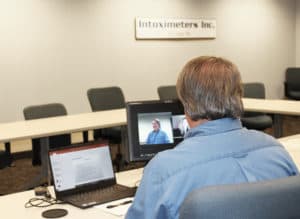As the COVID-19 pandemic continues, companies are continuing to restrict travel and meeting sizes, including in-person trainings. In addition to a highly increased demand for online training, we have also noticed some customers continuing to request the benefits of in-person, classroom training, and have adjusted some of our classroom procedures to accomodate for safety. Whether you opt for online training, or for in-person classroom training, we hope you’ll find the following guidelines helpful for both the safest and most thorough training experience during these unusual months of the pandemic.
Classroom Training
Several precautionary measures should be put in place when considering classroom training. These apply whether you are a BAT Instructor training at your location, or if you’re attending a BAT certification course. Look for the following precautionary measures:
Social distancing: Following the guidelines of the CDC, the Intoximeters Training Academy has adopted strict social distancing policies in our classroom training settings. Students are spread out throughout the classroom, at a minimum of 6 feet. We recommend adapting the classroom layout to accommodate social distancing, and using separate desks for each student, rather than forming tables into rows or a “U” shape. We also recommend limiting classroom size. Just as social distancing affects how many persons can enter a building, a room, a restaurant, etc, it also should limit how many students are in your BAT training classrooms at one time. Consider doing morning and afternoon sessions, and splitting your group in this way, rather than requiring too many people in one space at the same time. Of course, temperature checks and screening questionnaires should be completed by all students entering the classroom.
Wear masks: Be prepared to provide masks for each student in the event they show up without one. Communicate ahead of time that students will be required to wear masks, but still have clean, new masks ready for distribution so you don’t have to turn anyone away. Students should be required to wear masks throughout the class. To blow a breath sample for a mock test, the student should carefully lower their mask, provide the sample directly into the mouthpiece, and then place their mask back into position. The BAT may hold the instrument at a full arm’s length for his/her partner to provide a mock sample. BAT’s not providing samples should continue to wear masks throughout the class and each mock test.
Sanitation: Instruct all students to immediately dispose of used trash and mouthpieces after use. Do not allow used mouthpieces on any tables. They should be properly ejected from instrument directly into the waste container to eliminate contamination or the spread of germs. Provide trash receptacles at every table. Also have hand sanitizer and antibacterial wipes nearby, however do keep the hand sanitizer clear from the instrument while testing.
Online Training
While we encourage in-person training as much as possible, we realize that even with the current precautionary measures in place many companies and individuals are opting for online training. Done correctly, online training can be very effective and is allowed by the DOT, with certain mandates being met.
 Mock tests: The DOT mandates that webcam training on mock tests must be done in “real time”. Follow the recommendations below for proper set up of equipment for a webcam-based class. Done properly, webcam training can be quite successful and effective.
Mock tests: The DOT mandates that webcam training on mock tests must be done in “real time”. Follow the recommendations below for proper set up of equipment for a webcam-based class. Done properly, webcam training can be quite successful and effective.
Adjustable camera: The class instructor must be able to fully see the trainee perform the mock tests. An adjustable camera is very helpful for both the instructor and the trainee to have in order to accomplish this. Remember, as the instructor, you must sign off that the trainee completed all mocks according to DOT procedure and they are all error-free. You, as the instructor, MUST be able to see these mocks properly to sign off on them.
Audio: Be sure sound is clear before starting class. It is important for both the instructor and the trainee to hear one another during the session. Limit background noise. Headsets are a great way to limit background noise if eliminating the noise completely is impossible. However, it is highly recommended to be in a quiet, undisturbed location for the entire training.
Materials: The trainee should receive all of the necessary materials prior to the training. Examples of required training materials include DOT AFTs and/or CCFs, mouthpieces, water (to simulate a urine specimen for Collector courses), split collection kits, calibration log books, dry gas tank and regulator. As a trainee, be sure to have all the necessary materials ready for when you start your online class.
Whether you will be holding an in-person classroom training, or an online virtual training, make sure that you follow the correct DOT procedures. Even in these unprecedented times, all DOT procedures are still necessary, and in fact become vitally important for a quality, successful training class. Do not take any shortcuts. Even with social distancing and virtual training increasing, we can make sure that training is of the highest standard and quality and should ALWAYS meet or exceed the training requirements that are set forth by the DOT 49 CFR, Part 40.
Visit the Intoximeters Training Academy’s course schedule for DOT-regulated and non regulated training courses for more information on the courses we provide.
![]()
